Are you a Quiet Speculation member?
If not, now is a perfect time to join up! Our powerful tools, breaking-news analysis, and exclusive Discord channel will make sure you stay up to date and ahead of the curve.
Continuing on with article types that have been vanishingly rare this year, it's time to look at the lessons from a specific tournament. I haven't done this since February because there just haven't been any Modern tournaments. Wizards has neglected every other format in order to push Arena. Which means that other competitive formats have been neglected. I get why they'd push the new kid heavily (gotta make that investment back somehow), but the viewing numbers for non-League Weekends have not been too inspiring. And the event I'm covering today did as well or better than previous Arena events. Maybe it's time to embrace format diversity and use MTGO for Pro-level play, Wizards.
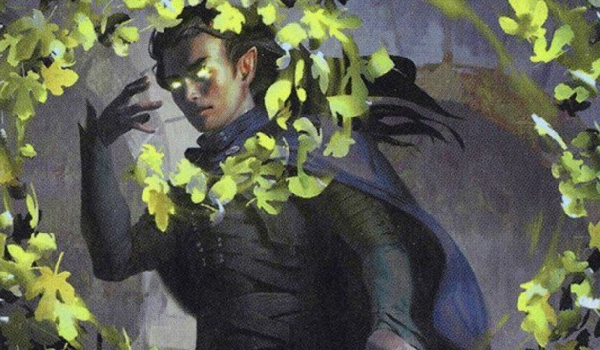
After being delayed almost an entire year, the 2019 Magic Online Championship Series finally took place last weekend. Wizards normally holds those at their headquarters as a big LAN party, but the pandemic made that impossible. Given that the 2020 MOCS season is coming to a close, Wizards couldn't delay any longer. As with everything else in 2020, it happened remotely. I'll admit I haven't been especially plugged into professional Magic this year (Standard isn't my thing), but I didn't know the MOCS was happening until the broadcast started. Wizards really needs to get better at advertising. Anyway, there were 24 competitors playing Modern, Pioneer, and Vintage Cube so I finally have a Modern event to examine.
The Caveat
Every time I cover an invitational event, I need to start off the same disclaimer: do not read into the deck choices. This is an event with a very limited population, and the players know who's going to be there. If there's ever been a metagame to try and metagame against, it's invitationals. In the past, players have admitted doing this for invitationals. I don't know 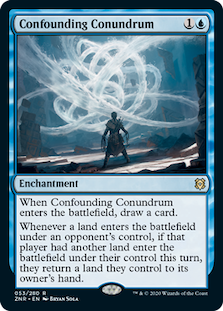 that this actually happened this time, but it could have successfully, unlike at an open event. Thus, deck choices should be viewed as potential reactions to the small population and anticipated opposing decks, rather than an accurate reflection of the Modern metagame at large.
that this actually happened this time, but it could have successfully, unlike at an open event. Thus, deck choices should be viewed as potential reactions to the small population and anticipated opposing decks, rather than an accurate reflection of the Modern metagame at large.
Assuming, of course, there was any thought put into Modern deck selection. Remember, this was a multi-format event. Which I heard but could not verify that participants were only told about two weeks ago. That's not much time to prepare for one format, let alone three. Players could easily have just grabbed whichever deck seemed most powerful. Or more likely, chosen one they were comfortable with regardless of its place in the metagame. Linked to that, final performance is absolutely not indicative of Modern strength. Players had to win in Modern, Pioneer, and Cube, and a mediocre Modern run can be more than made up for in the other two (which worked for Oliver Tiu). The utility of the MOCS Modern is to see where players' heads were and to look at how games played out, not to make metagame predictions.
MOCS Metagame
With that aside, what did show up to play?
| Deck Name | Total # | Total % |
|---|---|---|
| 4c Omnath | 4 | 16.67% |
| Temur Scapeshift | 2 | 8.33% |
| Temur Uro | 2 | 8.33% |
| Oops, All Spells | 2 | 8.33% |
| Scourge Shadow | 2 | 8.33% |
| Heliod Company | 2 | 8.33% |
| Eldrazi Tron | 1 | 4.17% |
| Jund Shadow | 1 | 4.17% |
| Humans | 1 | 4.17% |
| Mono-Red Prowess | 1 | 4.17% |
| Jund | 1 | 4.17% |
| Amulet Titan | 1 | 4.17% |
| Burn | 1 | 4.17% |
| Mono-Green Tron | 1 | 4.17% |
| Ad Nauseam | 1 | 4.17% |
| Bant Spirits | 1 | 4.17% |
Uro, apparently. Exactly one third of the decks had Uro, Titan of Nature's Wrath. He was paired with A-Omnath, Locus of Creation half the time. That is impressive, and two Uro players did make the playoff, but don't forget the caveat, especially since one pilot was the aforementioned Oliver Tiu. I'll be discussing Uro in its own section.
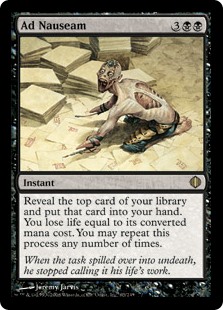 Looking through the rest of the results, it strongly looks to me like a number of players didn't extensively test Modern and brought their pet decks. At least that's the only explanation I have for why Joseph Burket brought Eldrazi Tron. Modern is a format for deck mastery, but that only goes so far. The evidence is pretty clear that Eldrazi Tron is not a good choice in the Uro/Scourge of the Skyclaves meta. Similarly, there is a reason Ad Nauseam has plummeted down the metagame tiers. Jamie Schonveld stuck with the deck anyway and didn't have a good time.
Looking through the rest of the results, it strongly looks to me like a number of players didn't extensively test Modern and brought their pet decks. At least that's the only explanation I have for why Joseph Burket brought Eldrazi Tron. Modern is a format for deck mastery, but that only goes so far. The evidence is pretty clear that Eldrazi Tron is not a good choice in the Uro/Scourge of the Skyclaves meta. Similarly, there is a reason Ad Nauseam has plummeted down the metagame tiers. Jamie Schonveld stuck with the deck anyway and didn't have a good time.
Again, this meta is not indicative of reality, but the deck choices do make me think that Modern was an afterthought for many players. They stuck with decks they were playing last year when they actually qualified for the MOCS. Dance with the one that brung ya, after all.
Consulting the Peanut Gallery
Normally, I wouldn't give much consideration to what the Twitch Chat said (Have you seen what goes on in there? I've seen things. Things that can't be unseen). However, I was very surprised to see that Chat was generally happy with the Modern portion. There were a few general grumbles, but none of the vitriol that I was expecting. The viewership was happy to watch something besides Arena, first of all, and appreciated the variety of decks that were featured. The gameplay was entertaining and more importantly the consensus said that the metagame seemed healthy. Even when the Uro decks were being featured, there wasn't a great deal of banning calls or complaining. I was impressed.
The Uro Issue
That said, I would be remiss if I didn't address the one consistent complaint among the complainers: Uro is too good. The complaints were lodged in relation to the 4c Omnath decks (as far as I saw, anyway), but weren't actually against the deck. The problem complainers had were always against Uro, specifically. And I think that they're fair.
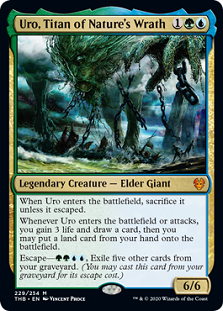 Uro is an absurd card. This is especially true when compared to its counterpart, Kroxa, Titan of Death's Hunger. Despite a costing a mana more, Uro is unquestionably more powerful because it does far more. Kroxa either takes a card from the opponent or costs them three life, an outcome opponents have some say in. Uro always draws a card and gains three life. Sometimes, it also ramps. Wizards clearly has a handle on resource denial mechanics, but clearly underestimates resource acquisition.
Uro is an absurd card. This is especially true when compared to its counterpart, Kroxa, Titan of Death's Hunger. Despite a costing a mana more, Uro is unquestionably more powerful because it does far more. Kroxa either takes a card from the opponent or costs them three life, an outcome opponents have some say in. Uro always draws a card and gains three life. Sometimes, it also ramps. Wizards clearly has a handle on resource denial mechanics, but clearly underestimates resource acquisition.
As a result, that lingering question of banning Uro kept coming up. And this is not just something that Twitch Chat periodically thinks. It's always coming up on reddit too, and even makes it to Youtube channels. And, I get it. It's an annoying card and indicative of several years of questionable design from Wizards. Uro is something of a lightning rod, though it is justified. So I'll bite. Let's discuss whether Uro should be banned in Modern.
Banning Uro: The Case For
A lot of criticism focuses on Uro being very boring to play against. It's a durdly card that goes in durdly deck which really slows the game down. The lifegain makes it hard for aggro to compete and all the value makes it hard for midrange that isn't also Uro-based to keep up on cards. Combine it with Field of the Dead (another lightning rod card) and Omnath, and it's a deck that smothers opponents without ever outplaying them or doing anything particularly interesting. I've certainly felt that same boredom, but it's important to remember that fun is subjective. For every player that's bored to death by the Uro value game, there could well be another that's enjoying playing Uro's value game. I think that Uro does a lot of things that a lot of players like to do, which is why it's very popular. Thus, the fun argument is a wash, and not very persuasive to me.
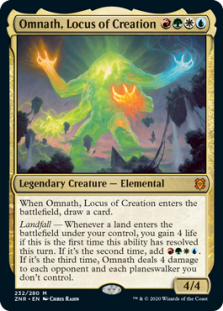 What is, and the case I'd make, is format prevalence. My data has shown 4c Omnath (which other sites call Uro Piles) taking up increasing metagame percentage. And that's just the headliner deck. Other versions have always been seeded throughout the meta. Together, they make up ~16% of Modern's metagame. Which is nothing compared to Twin's overall share before it was banned, but is reminiscent of both Oko, Thief of Crowns and Once Upon a Time. Overall diversity isn't directly impacted and there is considerable diversity within the "Uro deck" category, but again, that was also true for Oko. There's increasing indication that the metagame is becoming saturated by Uro in a way that has previously warranted a ban, which puts Uro firmly in the crosshairs.
What is, and the case I'd make, is format prevalence. My data has shown 4c Omnath (which other sites call Uro Piles) taking up increasing metagame percentage. And that's just the headliner deck. Other versions have always been seeded throughout the meta. Together, they make up ~16% of Modern's metagame. Which is nothing compared to Twin's overall share before it was banned, but is reminiscent of both Oko, Thief of Crowns and Once Upon a Time. Overall diversity isn't directly impacted and there is considerable diversity within the "Uro deck" category, but again, that was also true for Oko. There's increasing indication that the metagame is becoming saturated by Uro in a way that has previously warranted a ban, which puts Uro firmly in the crosshairs.
And lets be clear, the unifying piece of all these 3+ color goodstuff decks is Uro. Field and Omnath are played in a subset of the category, and even Omnath sees far more play than Field. Any "problem" with these piles is Uro itself, as everything else is just support for that card. And let me further be clear that the spread in the MOCS is not atypical for the data. November's data so far indicates that 4c Omnath will be on top of Tier 1, and not by a small percentage again. Consistently high metagame percentage is a reason to ban a card, which suggests that Uro's time is limited.
Banning Uro: The Case Against
However, I feel like that's unfair. The data may be pointing towards a ban, but I think it's a little deceptive. Uro doesn't behave like Oko did and simply invalidate huge swaths of cards. Uro pushes the UGx value decks in a similar direction, but not to the extent that Oko did, either. There's a lot more variation between Uro decks than there ever was with Oko. And there are still non-Uro value decks having success, which couldn't really be said for Oko. Burn may struggle against Uro the same way it did against Oko, but Prowess has been phenomenal this year. It feels like the situation is different enough that the data doesn't capture what's really happening. And based on my experience and things I saw during the MOCS, I think Uro gets away with a lot not on its own merits, but because of players not appreciating the deck.
Counterplaying Poorly
I think the biggest problem is players don't really understand how to play against the Uro decks, particularly 4c Omnath. This is not as scathing an indictment as may seem; there is a lot going on in those decks, and it can be very hard to know what's important and focus on what matters. I've also been the beneficiary of Omnath players making enough of the same evaluative mistakes to know that it goes both ways. The deck isn't too hard to pilot; it's understanding the game state and where the match actually stands that's the problem. And since Uro is a powerful card surrounded by powerful cards, its pilot can make more mistakes than opponents can, which translates into ignorance-driven wins.
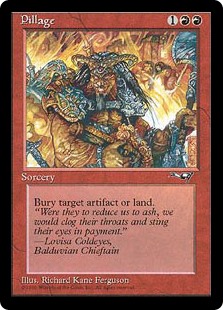 For example, during the Top 4 match between Oliver Tiu and Logan Nettles, there's a point where Logan attacks Oliver's lands with Fulminator Mages. The fact that Logan is running Fulminators rather than Breeches, Eager Pillager suggests that he hasn't tested the matchup extensively. Otherwise, he would have known about Veil of Summer protecting against Fulminator, a huge setback. This further suggests that Logan was relying on Jund muscle memory to pull him through, compounded the following turn where the second Fulminator went after Oliver's Triome rather than Field of the Dead. Logan managed to stay in the game despite multiple Uros and Omnath, but could never overcome the Zombies and lost.
For example, during the Top 4 match between Oliver Tiu and Logan Nettles, there's a point where Logan attacks Oliver's lands with Fulminator Mages. The fact that Logan is running Fulminators rather than Breeches, Eager Pillager suggests that he hasn't tested the matchup extensively. Otherwise, he would have known about Veil of Summer protecting against Fulminator, a huge setback. This further suggests that Logan was relying on Jund muscle memory to pull him through, compounded the following turn where the second Fulminator went after Oliver's Triome rather than Field of the Dead. Logan managed to stay in the game despite multiple Uros and Omnath, but could never overcome the Zombies and lost.
I don't know if Logan could have won if he played differently. Jund is a huge underdog to 4c Omnath. However, I know from experience with DnT that after the first few turns, it's better to save land destruction for utility lands (Field, primarily) than to attack Omnath's mana in general. Uro has too many fetchlands for a color screw plan to work. Logan obviously didn't know that, and so went for the color screw rather than Field. He ultimately lost after the Zombies Aven Fogbringerged a number of attacks, so I think that was the critical mistake. None of which may have mattered had he simply had Breeches, Eager Pillager over Fulminator in the first place. Misunderstanding the dynamics of the match definitely cost Logan.
Forgetting the Deck's Weaknesses
The other thing is that players seriously underestimate Uro's weaknesses. My examples for this come from the Pioneer matches, but they apply equally to Modern. Michael Jacob won in large part thanks to Karn, the Great Creator wishing for Grafdigger's Cage. Logan's entire gameplan at that point hinged on Uro at that point. Sultai Uro couldn't really deal with a constant stream of monsters and 'walkers any other way. Logan had played the game as if he would escape Uro and ride it, but with Cage out, couldn't find his footing again. He didn't have the lands to get Shark Typhoon big enough to overcome Michael's monsters until it was too late. 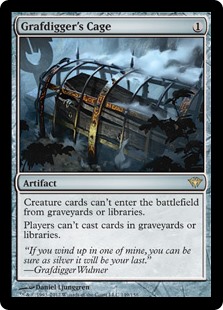 Most Uro decks need Uro to be good because that's their main engine. Graveyard hate remains crippling against the deck.
Most Uro decks need Uro to be good because that's their main engine. Graveyard hate remains crippling against the deck.
The other thing is players don't appreciate how fragile the whole deck really is. According to a thread in the chat, Michael had tested Logan's exact Sultai Uro list for Pioneer. Despite being 15-0 in League play, he rejected the deck. It fell behind too easily on the draw, was too vulnerable to graveyard hate, and required too much skill to just pick up in the time he had. This is a key point, because Logan spent a considerable amount of time playing from behind. And despite some very good play, it wasn't enough to overcome the tempo lost from Uro decks just durdling around. And this wasn't unique to Logan's situation; it cost Tiu a game, too. The ideal Uro value curve is overwhelming on the play, but very bad on the draw. I don't think players appreciate how critical it is to keep Uro off it's game in the early turns. Specifically, taking the Uro with discard or countering it. That first Uro trigger is essential to its gameplan the same way that a spark is necessary to make fire. Uro is far from unbeatable, but players don't try to exploit that weakness enough.
Hoping for More
I'm not saying that Uro is safe in Modern. If Wizards sees something they don't like in their far more extensive data, I could definitely see a banning coming down in January. I just don't know that it's as deserved as previous bans. I'm not necessarily any better about it, but it feels like too many players let Uro decks get away with being durdly piles due to misunderstanding the matchup. Hopefully I'm right and improved gameplay fixes the issue, but we'll have to wait and see.




I know that “diversity” is the primary consideration with regards to format health, and I guess it should be. But I just can’t help but feel people place too much emphasis there and too little in, what seems to me, other important factors. I guess I understand why, diversity is easily quantifiable. It convenient to be able to look at an event and say X archetypes were represented in the top 8, 16, or 32 decks. It’s easy to go to MTGGoldfish and see that there are a Y number of decks on page 1 and say, “Welp, I guess Modern is okay”.
But I really don’t think it’s okay. Anything more than a cursory look would glean that, while there’s a slew of “decks” out there, there are really very few enjoyable play experiences to be had in modern. My experience (obviously take this with a whole shaker of salt) has been that there’s really only four genuine competitively viable options: Piles decks, Shadow decks, Titan decks, and Prowess decks (in all their various flavors–granted, there are many). That’s seems to be it.
I’m of the mindset that these decks have oversaturated the format, contributing to a mediocre play experience. These decks just make the playing modern redundant, and frustrating and, frankly, off-putting. There’s gulf which exists with regards to the level of consistency of play and power here that few other decks can bridge. Moreover, these groups of decks are remarkably resilient to hate and/or avenues of attack by opponents. The few decks that can keep up with them, like “Oops All Spells” are so fundamentally busted that they’re worth looking at a banning on principle (at least in my view–and let’s be honest, squaring off against an “oops all spells” deck isn’t really what I’d call an enjoyable play experience either). All of which leads me to wonder–should we be less focused on diversity (how many decks there are) and more focused on addressing power and consistency discrepancies that exist between decks and, more broadly, archetypes? I don’t imagine that I am the only one who is frustrated by the gap that exists between the haves and have-nots of modern.
But even if this were a concern Wizards and the community decided to consider, how would we even quantify it? Numbers of players participating in competitive play? I mean, maybe that would work, but even if numbers were dipping in modern, how would we know why? Especially in 2020.
I’m desperate for Wizards to say something, ANYTHING, about these format boogeymen (that’s what I’m going to call them). I’m desperate to hear something, ANYTHING, from Wizards about what their plans are to bolster archetypes that are struggling at the fringes of playability and relevance. But I don’t honestly know where to go to hear genuine and nuanced discussion apart form the few resources out there like Modernnexus. If you happen to know, I’d be very appreciative of a point in the right direction.
It is all very subjective, and the very things that you dislike many other players like about Modern right now. What I think we can all agree on is that lack of paper play is severely impacting the format. Wizards has been neglecting us as they lavish praise on Arena (which I’d really like to know if it’s paying off) and unfortunately, content creation on Modern is also very down. Just the breaks this year. It also makes me think that Wizards won’t consider action (assuming it’s even necessary) until paper resumes.
As for the measuring health, it is an unsolvable issue. Any measurement is at least somewhat arbitrary and will be great at measuring some aspect while ignoring others. The least subjective is to look at the participation data, as I do, but that doesn’t measure player satisfaction. And there’s no way to reliably measure that outside of polling, which has lots of its own problems. I’ve not been happy with just MTGO data (not that I have a choice) because there’s no accounting for the impact that popular streamers and ease of deck choice have on the metagame. Overcoming such problems would require effort and funding on par with getting a PhD.